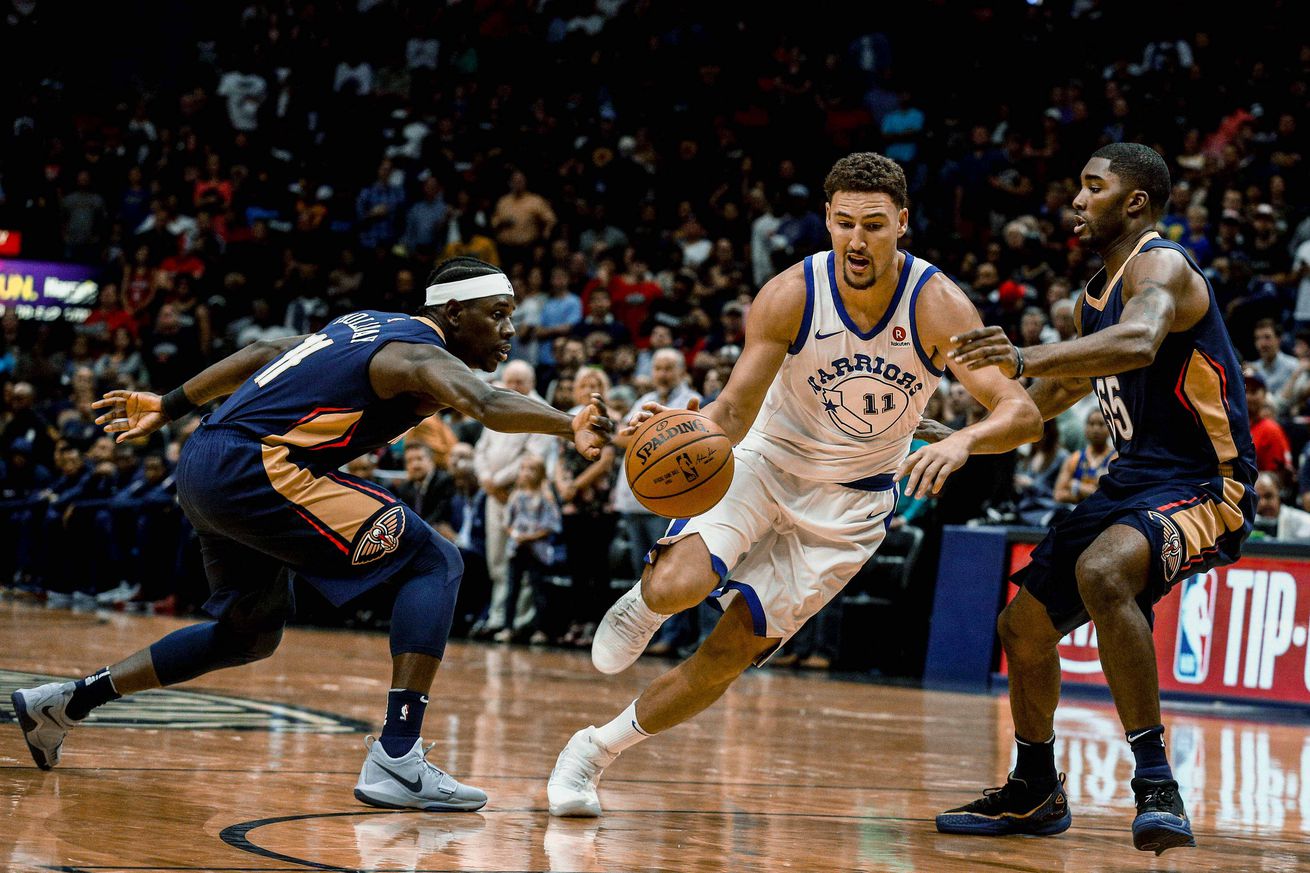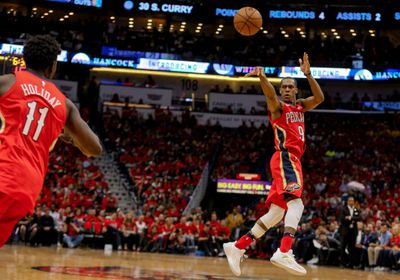MikeDelayo
Guest
Offline

Lonzo Ball, Josh Hart and JJ Redick could help Jrue Holiday wreak havoc on opposing guards
Solomon Hill’s brutal hamstring injury in the run-up to the 2017-18 season cost him valuable years of prime athleticism and playing time, a price no basketball player should ever have to pay. New Orleans could not wait for the potential long-awaited savior of the small forward position though, and needed Alvin Gentry to recalibrate his planned rotations with great haste. The result: a three-guard backcourt to accompany Anthony Davis and DeMarcus Cousins.
Gentry was open about his intention to fill the bulk of backcourt minutes with three of Rajon Rondo, E’Twaun Moore, Ian Clark, and, to a lesser extent Jameer Nelson (yes, he was on the team!) and Tony Allen (him too!), and most importantly, Jrue Holiday, who would be tasked with guarding the Paul Georges and Kevin Durants of the league (which he did quite well!) Unfortunately, Hill’s return to action at the end of that season and throughout 2018-19 struggled to justify any price, much less the one his contract paid. Save for occasional contributions from Darius Miller and Kenrich Williams, a one-year, three-guard stopgap became a two-year exercise, with Elfrid Payton, Frank Jackson and Nikola Mirotic filling in the minutes that the California-bound Rondo and Cousins left behind. A playoff series victory against the Portland Trail Blazers in 2018 may not have been the sweetest of possible lemonades, but with a $48 million lemon in tow, it was tough to expect much more. With Hill now off the books after a draft night trade with Atlanta (and since has been moved to Memphis in a package for Chandler Parsons), the Pelicans can finally afford to be proactive with their strategizing rather than reactive.
But does that mean three-guard lineups will now be a thing of the past?
Not quite.
The Pelicans agreed to terms with veteran sharpshooter JJ Redick, who figures to factor heavily into Gentry’s gameplan for the two seasons of his contract, 6’4” frame and all. With Jrue Holiday, Lonzo Ball, Frank Jackson, Josh Hart, Nickeil Alexander-Walker and E’Twaun Moore all in the mix for the time being, it seems impossible to adequately distribute minutes across twelve active players without at least occasionally playing three guards, especially considering Brandon Ingram’s likely significant role on the wing.
With that said, it is worth exploring just how productive the Pelicans’ smaller backcourts from the last two years proved to be, and what can be expected from those to come.

Rajon Rondo flinging a pass towards Jrue Holiday, who is hoping to catch it, during a May 4, 2018, contest in New Orleans.
Since 2017-18, 12 unique three-man combinations have shared the backcourt for at least 48 minutes, totaling a combined 2,480 minutes of game time, which equates roughly to 52 games worth of minutes (31.7 percent) of the total 164. Here is a table of each combination separated by season and ranked by minutes played. Also provided are their respective offensive, defensive and net ratings (points per 100 possessions scored and allowed as well as the difference between the two), all below the same metrics for the overall team in those seasons:
The trios that got the most run in each season, Rondo/Holiday/Moore in 2017-18 and Payton/Holiday/Moore in 2018-19, combine to represent 58.4 percent of the total minutes played, with the prior accounting for nearly half (46.3 percent) of the sample on its own. On the surface, the discrepancy between these two may suggest that the Pelicans wanted to shy away from the strategy in their most recent season, but bear in mind that the latter trio missed a combined 84 games, limiting their workload to just 21 games.
That missed time is a real shame because the Payton/Holiday/Moore pairing’s +9.6 net rating ranks third-best and is by far the highest from last season, which was 2.4 points per 100 possessions worse for the team overall. A bevy of stats indicate that the Pelicans were better with this group on the floor: their 2.24 assist-to-turnover ratio trumped the team’s 1.82 mark, as did their true shooting percentage (59.8 to 56.3) and, perhaps most surprisingly, their rebound percentage (52.6 to 50.9). That both the offense (115.4 to 110.6) and the defense (105.8 to 111.9) were better is about as good an endorsement as there is of what this undersized group was able to accomplish.
At least one of Holiday and Moore were a part of each of the above combinations, and that includes their time alongside Rondo, which was almost as effective as it was frequent. Despite the team being better overall, this lineup was still able to best the overall averages in each of the above metrics, albeit with slightly less drastic differences, and its net rating was fifth best relative to the season-in-question’s team mark. Considering that two of the lineups that rank above it in that respect were on the court for just 145 minutes combined, just 12.6 percent of its total, this trios positive impact may be more pronounced than any other.
Some guard combinations were not nearly as good. Rondo/Clark/Holiday, Nelson/Holiday/Moore and Frazier/Holiday/Moore make up the bottom three with respective net ratings of -10.7, -8.8 and -6.3. The repulsiveness of some of these figures, particularly the 74.8 offensive rating that pulled the Rondo/Clark/Holiday grouping into the abyss, help to highlight the problem the looms over every combination, both productive and not, on this list: for as depleted as they’ve been on the wing, the Pelicans guard situation has arguably been just as dire.
Here is a table of all of the guards mentioned above, ranked by WAR (calculated by FiveThirtyEight):
If not for the exploits of Holiday, this could be one of the worst collections of guards in basketball, with just as many below-replacement level seasons as those above it. Anthony Davis certainly played a part in buoying some of the lineup data above, but the fact of the matter is that the use of three guards at a time appears to have legs in Gentry’s system, even with such uninspiring complements to Holiday. However, the signing of Redick and trade of Davis have bolstered the backcourt to an extent that should spring the strategy to new heights.
Ball and Hart were underwhelming and inconsistent in the minds of many over the course of the past two seasons, but compared to who the Pelicans have trotted out, they would have been marked improvements. They averaged 2.3 WAR and 1.8 WAR respectively, marks that in either season would have easily slotted into the second- and third-best slots on the New Orleans roster. FiveThirtyEight’s CARMELO projections have Hart remaining at or around that perfectly-acceptable level, but they see Ball as a player who could soon break out in a big way (a projection among others of the Pelicans that we’ll explore in more detail in the weeks to come.)
The 35-year-old Redick is 13 years older than Ball and 11 older than Hart, but he is much further from washed then fellow trigenarians Rondo, Nelson and Allen were during their New Orleans tenures. In fact, his recent seasons have even outpaced the young guns by quite a bit, finishing 2017-18 with 3.4 WAR and 2018-19 with 4.7.
His two seasons in Philadelphia were spent among giants, most recently sharing the floor with the likes of Ben Simmons, Jimmy Butler, Tobias Harris and Joel Embiid, each of whom has at least a few inches on the former Duke star. As a member of the 2016-17 Clippers, however, he was often the unofficial “three” in three-guard lineups that featured various combinations of Chris Paul, Austin Rivers, Raymond Felton and Jamal Crawford. Here are the four that were used most frequently:
Three of these four lineups performed better than the team overall. The one that did not still outscored opponents by 2.1 points per 100 possessions, and the second-best managed its success despite excluding Paul from its ranks. Time has passed since then, but Redick’s mobility and shot-making ability have wavered just slightly, and figure to age well enough. Ball and Holiday figure to be his most common comrades in three-guard scenarios, and that bodes well for all involved. Zion Williamson and Derrick Favors may not do what Anthony Davis did on paper (yet!), but they will not be detriments to their smaller teammates by any means.
The prospect of more three-guard lineups may be scary for some Pelicans faithful, but their track record in New Orleans has been much better than the players who have been a part of them, and an influx of talent should make these trios better than ever when they’re inevitably called upon. If it does, a return trip to the postseason may be in the cards much earlier than some may have thought.
For what it’s worth, Redick has never missed one.
Continue reading...

